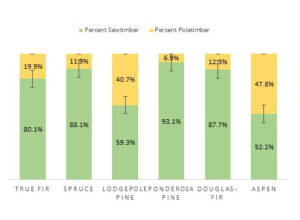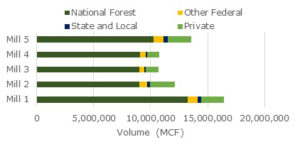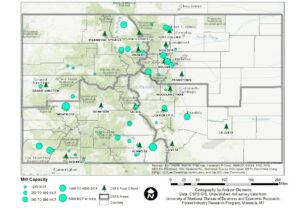Authors:
- Caleb Marucci, Research Associate II, Colorado State Forest Service
- Drew Clements, FIA Supervisory Forester, Colorado State Forest Service
Editors:
- Sara Goeking, FIA Deputy Program Manager, USDA Forest Service Rocky Mountain Research Station
- Wilfred Previant, PhD, Assistant Professor, Warner College of Natural Resources, Colorado State University
- Amanda West Fordham, PhD, Associate Director of Science and Data, Colorado State Forest Service
- Kurt Mackes, PhD, Research Scholar, Colorado State Forest Service

The Forest Inventory and Analysis (FIA) program of the USDA Forest Service, in collaboration with the Colorado State Forest Service, conducts and continuously updates an inventory across all forested lands in Colorado and Wyoming. Certified, highly trained foresters and research associates survey hundreds of permanent research plots annually, measuring 10 percent of the forested plots each year.
The inventory includes information about tree species, growth, volume, mortality and quality, as well as information on vegetative species cover, fuel loading and soils. Information presented in this Science & Data Bytes post comes from the most recent 2019 FIA inventory and uses data collected 2010-2019. This post also uses information from mill surveys published in 2016 by the FIA Timber Products Output program.
Timber Industry’s Contributions to Economy
Timber provides a long-term carbon sink, reducing the amount of carbon dioxide that enters the atmosphere, and it also plays an important role in the economy. The timber industry is an important economic driver in Colorado both for the jobs it provides and the products and revenue it generates. Over $98 million of finished product sales were generated from Colorado’s primary wood processors in 2016 (Hayes et al. 2016). In 2016 almost 100 percent of the timber harvested in Colorado came from ponderosa pine, lodgepole pine, spruce (blue and Engelmann), true firs, Douglas-fir and aspen (Hayes et al. 2016). As of 2019, Colorado has over 20 million MCF (1,000 cubic feet) in merchantable bole volume of live growing stock in these tree species (Figure 1) (USDA 2020).

Just over 75 percent of this 20 million MCF resides in national forests, and altogether 83 percent of it lies on public lands (USDA 2020). In 2016, sawtimber accounted for 80 percent of the total volume harvested in Colorado, and nearly 65 percent of all timber came from national forests (Hayes et al. 2016). Most of the trees growing on timberland in Colorado have the potential to be used as sawlogs (Figure 2). However, a much more in-depth analysis would need to be done to discover how much volume of the 20 million MCF is available and feasible for harvest.
Measuring Accessibility of Timber
While ease of access for a potential timber sale is not solely determined by the operation’s distance from an improved road, it does have an important bearing on cost and feasibility. Most of the volume in Colorado is located 1 mile or less from an improved road (Figure 1). However, a more accurate metric for measuring the accessibility of timber is the proximity to a mill and the capacity of said mill. Due to rising haul and harvesting costs, there is more of an incentive to keep haul distances to 150 miles or less to maximize the number of loads taken to a mill per day per truck to increase profits (Hayes and Niccolucci 2020). As seen in Figure 3, there is a large amount of volume that falls into this category (note that some of the shown in Figure 3 is overlapping between mills).

Decline in Wood Processing Facilities
It is important to note that primary wood processing facilities in Colorado have been in decline, down from 133 in 2002 to 57 in 2019 (Figure 4). A variety of factors have contributed to this decline, including a decline in the value of timber due to insect and disease outbreaks, as well as an increase in harvesting and treatment costs. However, this decline began in the 1980s, mainly due to the lack of a sufficient, consistent supply of higher quality sawlogs. The decreased number of mills means that there is less timber harvest capacity to meet future increases in demand for wood products or for forest treatments that include harvesting.

Definitions
Growing stock: All live trees at least 5 inches diameter at breast-height of commercial species that meet minimum merchantability standards. In general, these trees have at least one solid 8-foot section, are reasonably free of form defect on the merchantable bole, and at least 34 percent or more of the volume is merchantable. Excludes rough or rotten cull trees.
Timberland: Forest land that is producing or capable of producing in excess of 20 cubic feet per acre per year of wood at culmination of mean annual increment (MAI). Timberland excludes reserved forest lands.
Merchantable: Refers to a pulpwood or sawlog section that meets pulpwood or sawlog specifications, respectively.
Net volume in cubic feet: The gross volume in cubic feet less deductions for rot, roughness and poor form. Volume is computed for the central stem from a 1-foot stump to a minimum 4.0-inch top diameter outside bark, or to the point where the central stem breaks into limbs.
Improved roads: Paved roads, gravel roads or improved dirt roads regularly maintained for long-term continuing use.
Sawtimber tree: A tree with a diameter at breast-height greater than or equal to 9 inches for softwoods or greater than, or equal to 11 inches for hardwoods.
Poletimber tree: A tree with a diameter at breast-height greater than or equal to 5 inches and less than 9 inches for softwoods, or greater than or equal to 5 inches and less than 11 inches for hardwoods.
References
Hayes, S., & Niccolucci, M. (February 2020). Logging cost estimation for Idaho and Montana. PowerPoint Presentation. http://www.bber.umt.edu/pubs/forest/prices/LoggingCostPres2020.pdf.
Hayes, S.W., Bingaman, C.A., Morgan, T.A., Simmons, E.A., Marcille, K.C., & Shaw, J. (2016). The four corners timber harvest and forest products industry. Unpublished. Fort Collins, CO. http://www.bber.umt.edu/pubs/forest/fidacs/CO2016%20Tables.pdf
USDA. (2020). Forest Service, Forest Inventory EVALIDator web-application Version 1.8.0.01, St. Paul, MN: U.S. Department of Agriculture, Forest Service, Northern Research Station. https://apps.fs.usda.gov/Evalidator/evalidator.jsp

